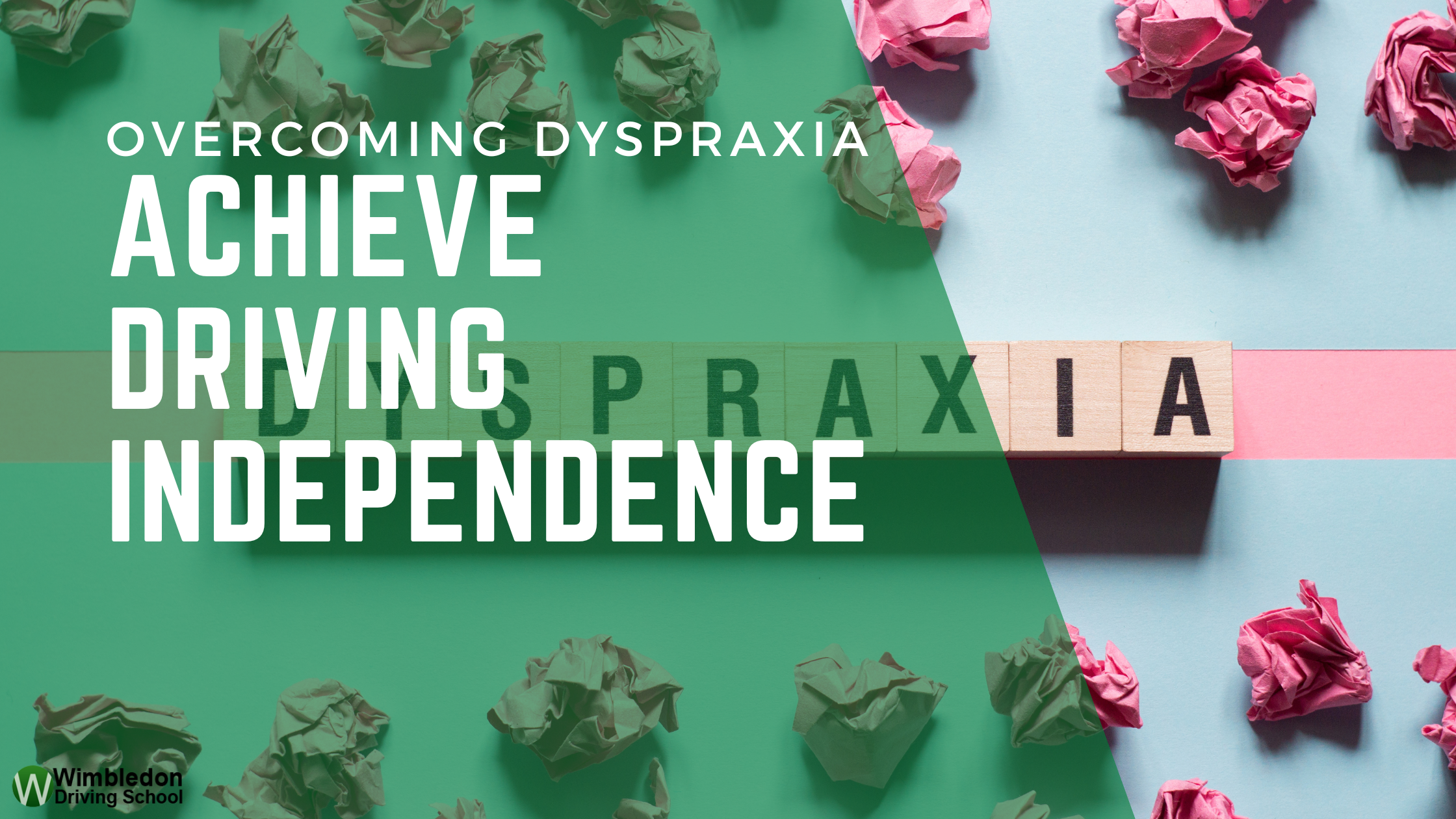“Everybody is a genius. But if you judge a fish by its ability to climb a tree it will live its whole life believing that it is stupid” – Albert Einstein (likely dyspraxia sufferer)
Introduction
Did you know that roughly 10% of the UK population has dyspraxia, a neurological condition that affects movement and coordination skills? Surprisingly, many people may not even realise they have dyspraxia, as it is a hidden condition.
The brain differences associated with dyspraxia are primarily related to the cerebellum, the part of the brain responsible for motor control and spatial awareness. For people with dyspraxia, the cerebellum may be smaller or underdeveloped, leading to difficulties with fine and gross motor skills, spatial perception, and sensory integration.
Learning to drive with dyspraxia can be especially challenging due to these differences, but there are strategies and tips that can help. In this article, we will explore the challenges associated with dyspraxia and learning to drive, and provide helpful tips and strategies for overcoming them.
Behind the Wheel with Dyspraxia: The Unique Challenges of Learning to Drive
Understanding the unique challenges associated with dyspraxia is key to improving the learning process for individuals with this condition.
By acknowledging and addressing these challenges, both learners and instructors can work together to create a more effective and supportive learning environment. Informing your instructor about your condition can help them tailor their teaching approach to address the areas that require attention.
Below are the issues to be aware of:
Motor Coordination Difficulties: The Struggle is Real
Controlling movements and coordinating limbs are essential skills for driving. However, for people with dyspraxia, this can be an uphill task.
Operating the car pedals, gears, and steering wheel can become extremely difficult, making clutch control, gear changes, steering, and braking a real struggle. For example, a person with dyspraxia may find it challenging to coordinate their feet to operate the clutch and brake pedals smoothly.
Spatial Awareness Problems: Navigating the Roads is a Challenge
Dyspraxia can make it hard to judge distance, speed, and position, making it challenging to manoeuvre the car safely on the road.
This can lead to difficulty with parking, reversing, and changing lanes. For example, a person with dyspraxia may struggle to judge the distance between their car and other vehicles or objects, making it difficult to park or reverse.
Memory and Sequencing Issues: Remembering the Rules of the Road
For people with dyspraxia, remembering the steps involved in driving can be a daunting task. Checking mirrors, signalling, and changing lanes can be hard to remember, as can traffic rules and regulations. This can make it difficult to make quick decisions while driving and may impact their ability to respond to changing road conditions.
Difficulty with Multi-Tasking: Focusing on the Road Ahead
Driving requires a person to monitor the road, operate the car controls, and make decisions quickly, which can be challenging for people with dyspraxia who may struggle with multitasking. They may find it difficult to focus on several things at once, such as checking mirrors, using the pedals, and following directions. This can impact their ability to drive safely and confidently.
Anxiety and Stress: Overcoming the Fear of Driving
Learning to drive can be stressful for anyone, but it can be especially overwhelming for people with dyspraxia who may feel anxious about their ability to control the car and navigate the road. This can lead to heightened stress and anxiety, which can further impact their driving ability.
Overcoming Dyspraxia: Strategies for Success
Revving up to learn how to drive with dyspraxia can be daunting, but there are strategies that can help overcome the challenges. Here are some key tactics to make the journey smoother:
Picking the Perfect Instructor and Car
Finding an instructor who can tailor instruction to the unique needs of someone with dyspraxia is critical. Additionally, choosing a car with automatic transmission can help eliminate the difficulties associated with gear changes and clutch control.
Practicing in Familiar Territory
Starting off in a quiet, familiar environment such as an empty car park or quiet residential street can help reduce anxiety and allow for more targeted practice before progressing to more complex driving situations.
Chunking
Breaking down complex tasks into smaller, more manageable steps can help individuals with dyspraxia to understand and complete them. Driving instructors can present driving tasks in a step-by-step manner and provide plenty of repetition and reinforcement.
Explicit instruction
Providing clear and detailed instructions can be helpful for individuals with dyspraxia who may have difficulty picking up on implicit or implied instructions. Driving instructors can be more explicit in their instruction, breaking down each driving task into clear steps and providing detailed explanations of how to complete each step.
Multi-sensory learning
Using a variety of sensory inputs can help individuals with dyspraxia to process and remember information more effectively. For example, driving instructors can use visual aids, hands-on activities, and audio recordings to reinforce learning.
Visual aids such as diagrams and pictures can help with understanding and retention of driving steps, while mnemonics like “mirror, signal, manoeuvre” can aid with memory and sequencing issues.
Mind Mapping
Mind mapping is a powerful tool that can benefit dyspraxia learners in their driver training. It involves breaking down complex information into manageable parts and creating a visual map to aid understanding and retention.
Some tips for creating mind maps for dyspraxia include using simple, clear language, using different colours or symbols for different categories or ideas, and keeping the map uncluttered and easy to read. Mind maps can also be adapted to suit individual preferences and learning styles, such as using pictures, diagrams, or audio recordings instead of written words.

Mind mapping offers four key benefits for dyspraxia learners:
1) reducing anxiety and overwhelm by simplifying the driving process; 2) improving organisation and understanding by categorising and prioritising information; 3) engaging multiple senses to enhance learning for dyspraxia learners who may struggle with traditional auditory methods; and 4) developing a deeper understanding of the driving process, leading to increased confidence and independence on the road.
By incorporating mind mapping techniques into driver training, dyspraxia learners can become more successful and confident drivers, improving their quality of life and sense of independence.
Managing Stress and Anxiety
Stress and anxiety can be a significant barrier to learning to drive. Relaxation techniques such as deep breathing and visualisation can help promote calmness while driving.
Drive Without Limits: The Ultimate Guide to Registering with DVLA and Mastering Driving with Dyspraxia
Declaring Dyspraxia to the DVLA
Dyspraxia only needs to be declared to the DVLA if it affects safe driving. Those with dyspraxia who meet the standards of safe driving don’t need to declare their condition.
Dyspraxia and Learning to Drive: Experts Suggest 40-50 Hours as a Minimum for Passing the Driving Test, According to DyspraxiaFoundation.org.uk.
The Dyspraxia Foundation has noted that every learner and every person with dyspraxia is unique. Instructors estimate that an “average” learner needs approximately 40 to 50 hours of lessons to pass their driving test.
However, for someone with dyspraxia, this estimate is likely to be a minimum, indicating that more time may be necessary. This suggests that individuals with dyspraxia may require additional instruction and practice to reach the same level of proficiency as non-dyspraxic drivers.
Case Study
Get ready to hear the inspiring story of our female client from Tooting, South-West London. Despite working with multiple driving instructors previously, she still faced challenges with learning to drive.
Her lack of confidence was a result of her previous instructor frequently intervening by grabbing the wheel, which led to a lack of trust. Additionally, she struggled to comprehend the instructions given to her during lessons, leading to confusion and uncertainty.
But we were determined to help her overcome these obstacles and become a confident driver. We provided her with references to maintain her position and coached her to slow down in tight areas. With our guidance, her positioning improved so much that she needed little to no steering intervention.
To help her understand complex concepts, we made use of engaging visual aids such as diagrams, YouTube videos, and Mind Maps. And when it came to handling hazards, we introduced her to the MSPSL routine (the DVSA hazard routine), breaking it down into manageable steps.
At first, we worked closely with her on the parts of the routine she struggled with, gradually giving her more responsibility as she gained competence. With constant repetition and a focus on the areas she found challenging, her sequencing problems abated, and she was able to take responsibility for the entire routine.
All her hard work paid off as she passed her driving test at Morden on her first attempt, with only two drivers faults. What an incredible achievement!
Conclusion
In conclusion, while learning to drive with dyspraxia can present numerous challenges, there are effective strategies and support available to help overcome them. Whether it’s finding the right instructor, using visual aids and mnemonics, or breaking down complex tasks into more manageable steps, dyspraxia learners have a range of tools at their disposal to help them succeed.
One particularly powerful strategy is the use of mind mapping, which offers multiple benefits that can lead to increased confidence and independence on the road. By implementing these strategies and seeking support, individuals with dyspraxia can successfully learn to drive and gain the freedom and independence they deserve.
The inspiring success story of our female client from Tooting, South-West London, serves as a testament to the effectiveness of these strategies, as well as the importance of determination and hard work in achieving driving independence





